AGRICULTURE
 Barbed Wire
Barbed Wire
Few inventions have the simplicity yet far-ranging impact that barbed wire had. Prior to the 1860s, rangeland was open and freely shared by livestock and wildlife alike. As the frontier was pushed west by the telegraph in 1861 and the railroad in 1869, protection of right-of-way became paramount. Ordinary fences were inadequate; what was needed was a boundary with a bite.
In 1867, a form of barbed wire was patented by Lucien B Smith of Kent, Ohio. The original invention was refined and improved upon by Joseph Glidden, Jacob Haish, Charles Francis Washburn, and Isaac L. Ellwood, in a series of contentious collaborations. A cheap and easy method for manufacturing barbed wire was eventually developed and by the end of the 1870s the age of cowboys and the open range was ending.
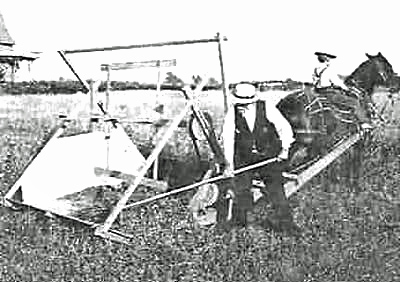 McCormick’s Reaper
McCormick’s Reaper
Mechanical reapers were much in demand in the 19th century, and a number of different designs were developed during that time period.
The most successful, however, was the McCormick reaper. It was a horse-drawn piece of equipment, patented by Cyrus McCormick in 1837. It offered a number of advantages over other reapers, namely a knife rather than reel cutting edge, a divider for the grain to be cut, and a reel to dispose of the cut grain. The design, while advanced, drew heavily on the work of Obed Hussey, who patented a reaper in 1833. The patent fights continued for years, until finally resolved in 1861.
IMAGE: See page for author [Public domain], via Wikimedia Commons: https://commons.wikimedia.org/wiki/File%3ACyrus_McCormick’s_reaper.jpg
ARCHITECTURE
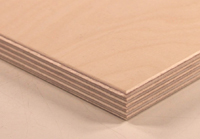 Plywood
Plywood
The creation of plywood really began in the late 1700s when Samuel Bentham patented machines which produced veneers. However, it was another fifty years before the next steps were taken.
Immanuel Nobel, father of Alfred Nobel, is credited with the realization that thin layers of wood bonded together would be stronger and less subject to warping than a single thick layer. He is also credited with the invention of the rotary lathe, a machine which efficiently produces the necessary veneer sheets.
By 1870, the process was well enough established in France that the French dictionary of the day described the manufacturing process in detail. Plywood came to the United States in 1865 and industrial production began shortly after.
IMAGE: By Bystander (Own work) [CC BY-SA 3.0 (http://creativecommons.org/ licenses/by-sa/3.0) or GFDL (http://www.gnu.org/copyleft/fdl.html)], via Wikimedia Commons
 Reinforced Concrete
Reinforced Concrete
Concrete reinforcement was used in 1853 by the Frenchman François Coignet for a Parisian building, but it was not employed to improve the strength of the material. It was not until 1867 that reinforced concrete was patented by a Paris gardener, F. Joseph Monier. who developed the product for use in garden tubs.
The idea was rapidly developed in both America and Europe over the next few years. In the mid-1870s an American, Thaddeus Hyatt, published a series of experiments using reinforced concrete which advanced use of the material without the need for costly and hazardous trial-and-error. G. A. Wayss, a German civil engineer, and Ernest L. Ransome, an English-born engineer, further improved on the techniques for use of reinforced concrete.
By the turn of the century, the use of the material was expanded to tall commercial buildings– the first skyscrapers.
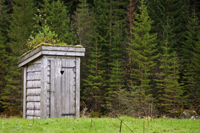 Indoor Plumbing
Indoor Plumbing
Indoor plumbing dates back to the days of the early Greeks, but modern flush toilets did not become available until the 1800s.
The first public ‘water closets’ were built in Hyde Park, London, during the Great Exhibition of 1851. By the end of that decade, most new middle-class homes were equipped with water closets.
By the 1880s, the siphon system flush fixtures designed by Thomas Crapper had largely replaced earlier floating-valve systems, and in 1885 the first modern flush-down toilets were developed by Frederick Humpherson in England.
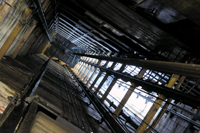 Elevators
Elevators
Hoists and winch-driven cages for transportation of men and equipment in mines had been in use since medieval times. However, use of these devices for everyday movement of passengers did not appear until the 1820s.
In 1852, Elisha Otis invented the safety elevator, which kept the cab from falling if the cable broke. Rollers locked the elevator in its shaft should it descend too quickly; a similar design is still is use today. The Equitable Life Building, completed in 1870 in New York City, was the first office building to have passenger elevators.In 1872 Cyrus W. Baldwin patented an electric elevator, which was installed in the Stephens Hotel in New York City.
Over the next few decades multiple advances were patented and put into use, including floor control, acceleration control of cars, safeties, multiple elevators in a single shaft, and safe opening and closing of elevator doors.
INDUSTRIAL
 Plastic
Plastic
The first moldable substances were varieties of natural rubber used for balls, figurines and the like. However, the first modern material was parkesine, patented by Alexander Parkes in 1856. It was a form of celluloid, and when Parkes’ company failed due to quality control issues his patents were taken up by an American, John Wesley Hyatt, who intended to use the material for billiard balls.
A series of additions and improvements to the material by various inventors followed, as did a rash of lawsuits over the ‘true’ inventor of the many variations produced. In 1878 Hyatt patented a method for injection-molding plastics, and by the turn of the century work had actually begun on bakelite, the first true synthetic plastic.
 Smokestack Scrubbers
Smokestack Scrubbers
Mary Walton was an American inventor who was instrumental in reducing pollution from factory smokestacks in the mid-1800s. In 1879, Walton developed a system (patent #221,880) which channeled smokestack emissions through water tanks, which captured the pollutants and later disposed of them through the city sewage system.
BUSINESS
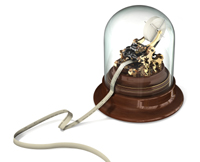 Stock Tickers
Stock Tickers
Western Union developed the first stock ticker in 1866, and in 1870 followed up with a standardized time service. The year following, 1871, the company brought out its money transfer service, based on its widespread telegraph network.
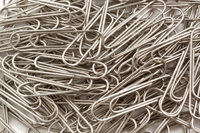 Paper Clips
Paper Clips
The first bent-wire paper clip in the U.S. was patented Samuel B. Fay in 1867. The present design, with its two concentric oval wire loops, was never patented, and made its appearance in England in the early 1870s. Like the humble safety pin, it was a simple, deceptively obvious invention with almost universal application.
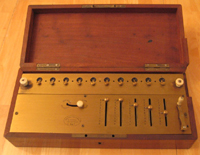 Adding Machine
Adding Machine
The mechanical adding machine was originally developed by Blaise Pascal in 1642, but it remained nothing more than a curiousity for over two centuries.
In 1851, Thomas de Colmar invented the simplified arithmometer, a more practical application which was tough and reliable enough to be used in an office environment. He was followed by Dorr E. Felt, who began manufacturing his comptometer in 1887. The final push for commercial acceptance came when Burroughs commercialized his modern adding machine in 1892.
IMAGE: By Ezrdr (Own work) [CC BY 3.0 (http://creativecommons.org/licenses/by/3.0)], via Wikimedia Commons
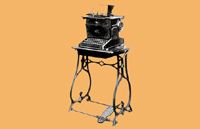 Typewriter
Typewriter
The first practical commercial typewriter was first developed by Sholes and Glidden in 1867. It was mounted on a sewing machine stand, and a footpedal was used to operate the carriage return. It utilized the familiar QWERTY keyboard layout still in use today, but could only print uppercase letters.
The design was acquired and further refined by E. Remington and Sons in 1873. Remington was an arms manufacturer looking to diversify after the Civil War, and hoped to take advantage of a burgeoning economy. The firm put the typewriter on the market in 1874, and it rapidly became a common office fixture.
FURTHER READING AND OTHER REFERENCES
Technology, Domestic
Communications
Lighting
Transportation
Website:
Virtual Typewriter Museum, http://www.typewritermuseum.org
(Posted June 2016)
